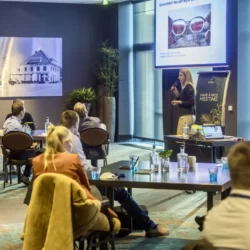Sean Culey: Current crisis is the prelude to a new golden age

The mass layoffs at Facebook, Google and Amazon and the bankruptcy of Silicon Valley Bank are all signs that we have reached a tipping point, beyond which lies the dawn of a new ‘golden age’ of innovation and prosperity, claimed Sean Culey during a recent Webinar Wednesday. The author of the book Transition Point is now also supply chain director of the British Manufacturing Technology Centre, which is working to accelerate the transition. “Numerous companies won’t survive this period,” he said.
By Marcel te Lindert
Sean Culey made a name for himself five years ago with his book called Transition Point, in which he argued that we were at the start of Kondratieff’s sixth wave. The first wave began with the invention of the steam engine and led to the industrial revolution. The sixth wave is the digital era. “When I talked about this ten years ago, we were still in the transition phase between the fifth and sixth waves. Today, we are already in the sixth wave,” Culey said on Webinar Wednesday, which as always was hosted by Supply Chain Media’s Chief Trendwatcher, Martijn Lofvers.
Mass layoffs
After a wave has reached its peak, it is followed by a period of decline. This happened during Kondratieff’s fifth wave too. “That’s the point when the technology can’t be developed any further and companies try to increase their profits by reducing costs. Everything becomes about efficiency, as we saw with the companies that relocated their production to the Far East. But now that volatility is increasing and demand is becoming less predictable, those companies are paying the price for their low-cost supply chains.”
No one can have failed to notice that the current transition from the fifth to the sixth wave is not running entirely smoothly, but that’s normal according to Sean Culey: “Every transition period is accompanied by social unrest and economic stagnation, leading to job losses and increased poverty. We’re seeing that again now; just think of the mass layoffs at the BigTech companies. There are winners and losers in every transition. Numerous companies won’t survive this period.”
Silicon Valley Bank
Unfortunately, the fact that we are now back in a period of upswing after the decline of the fifth wave does not mean that all the problems will soon be over. Culey explained this by referring to the research of scholar Carlota Perez, who argues that this period can be divided into two phases. The first phase involves a struggle between old and new paradigms – between the old and new ways of working. This revolves around the question of where to invest capital. “We see this in the field of artificial intelligence (AI). During the downturn of the fifth wave, a lot of research was done into AI but there was no money to be made from it. Companies found an easier way to make a profit, namely by cutting costs.”
That all changed once it became clear that companies could indeed use AI to create value and investment firms ploughed money into it. “This led to a hype surrounding the benefits of AI. But the bubble now seems to have burst, leading to the current chaos… as illustrated by the bankruptcy of Silicon Valley Bank. When we emerge from this, the second phase will start, in which many technologies will become mainstream. Some technologies will be cast aside, however, and not all companies will survive. This second phase will mark the dawn of a new golden age that will be accompanied by great prosperity.”
ChatGPT
When elaborating on the first and second phases, Culey explained that the first phase often revolves around new ways of doing existing things. For example, 3D printing is a new technology for making existing products, just more efficiently. “In phase two, those new technologies are used to do new things,” Culey said. “Take ChatGPT, for instance. Right now, the way we do certain things is completely changing. Whole new business models are emerging.”
Another example is the energy transition. The first phase consists of investments in solar panels and wind turbines. “But that’s basically nothing new. We’ve been using solar power and wind power for years; we’ve just found ways to make these energy sources much more efficient. In phase two, we’re looking at completely new energy sources, such as small modular reactors or projects where we try to extract solar energy from space. These are completely new ways of generating energy – ways that could change the world.”
Supply chain transformation
Sean Culey is currently active as supply chain director of the Manufacturing Technology Centre (MTC), a British institute that researches and develops new energy technologies like the ones he mentioned. The institute was founded in 2010 by four universities seeking to bridge the gap between academia and industry. “Since then, 96 companies have joined. They use the MTC to test new ideas and put them into practice. We are also busy designing things like components for reactors or hydrogen plants. My role is to transform the supply chain so that all the innovations we are working on can actually be implemented.”
Culey’s main task is to shorten project lead times, because many projects currently suffer delays due to having to wait for materials and machinery. “We possibly have the largest concentration of engineers in the world, or at least in the UK. Our engineers do a fantastic job, but supply chain management is not one of their strengths. They often arrange for parts to be flown in at the last minute. As a result, we might meet our project goals, but not our sustainability goals.”
Four phases
There are four phases to MTC’s supply chain transformation. The first phase consists of gaining insight into the supply chain. “You can’t manage the supply chain if you don’t understand what’s going on. Many companies make the mistake of diving straight into innovation. But then they lack an understanding of the customers, the business strategy and the causes of bottlenecks,” Culey stated.
The second phase revolves around learning how to manage the supply chain, and the third phase involves making improvements. “You can’t improve what you don’t manage, and you can’t manage what you don’t understand,” he summed up. “Working on improvements creates opportunities for innovation, new value propositions and new business models. You can then introduce them successfully knowing that they are based on a solid foundation. That puts you in the fourth phase of the transformation process. What I’m trying to do is ensure that we can develop and innovate faster.”










